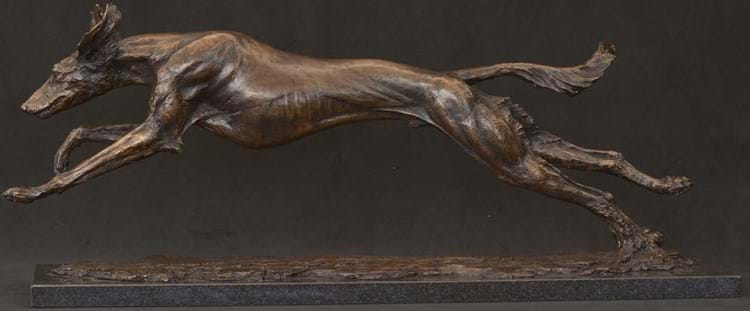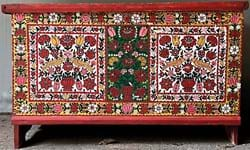So-called cold-cast bronzes are made from polyester resin (a type of plastic) with bronze dust added to the surface to give the object the appearance of real bronze.
Such works are routinely offered at low prices compared with the real items but are sometimes described online in a misleading way.
While cold-cast bronzes (sometimes referred to as ‘bonded bronzes’ in the US) are unlikely to fool specialist dealers and collectors, the term is not widely understood by the public.
Maurice Blik, a leading sculptor and former president of the Royal Society of British Sculptors, told ATG that the true nature of resin works is often concealed via their descriptions on websites. Sometimes these state items were made using ‘new techniques’ or were created with a process ‘allowing for greater detail’.

A poorly made resin version of Running Saluki copied using photos from the artist’s website. With resin lacking the strength of bronze, the ankle was not strong enough to support the one-legged running pose and the item broke in the post.
‘Deliberately misleading’
“I hate the phrase ‘cold-cast bronzes’,” said Blik.
“It’s deliberately misleading as the items have nothing of the quality of bronze. Making and casting sculpture in bronze requires high levels of skill, expertise and expense. The process to make these resin sculptures is technically simple; it can be done on the kitchen table.”
Objects have been created in this way since the early 1960s when it was discovered that polyester resin could be reinforced and materials, such as metal powders, added to create a veneer.
However, with ‘cold cast’ works now appearing on websites and selling platforms such as eBay, additional techniques to mimic the patina of antique bronze are now being adopted. These include adding acid to the surface and sealing it with wax to create tones not unlike the darkened or green coating that real bronze develops over time or the addition of iron filings to the resin to add weight and a more metallic feel.
“As a sculptor, I can tell the difference immediately but many non-specialists might not realise how they’ve actually been made,” he said.
He added that resin works were much more brittle than real bronze and small protruding parts (for example the leg of a horse sculpture) could sometimes be broken off with bare hands. “You could even try inserting a hot needle into the item. This would go through a polymer but obviously not real bronze.
“My concern is that this practice is widespread and as far as I know unchallenged, conning the public and undermining confidence in the legitimate art market. An analogy would be selling silver plate as silver, which is strictly controlled and illegal.
“Although some of the sellers/traders say that ‘cold cast bronze’ is a mixture of resin and bronze powder, they don’t say in what proportion. The real problem to my mind is that the term itself is really misleading, and I suspect found wanting under the Trade Descriptions Act. So if some regulation were possible it would help hugely.”
ATG contacted National Trading Standards to check whether the term ‘cold-cast bronzes’ falls foul of consumer rights and ask what powers are available for enforcement of standards protect the market, but was referred to the Chartered Trading Standards Institute and is still awaiting a response.
Tanya Russell, another bronze sculptor, agreed with Blik that the phrase ‘cold-cast bronze’ is often used as an “intentionally misleading marketing ploy”.
“This has been around a long time,” she said. “My parents are both sculptors and I remember them discussing cold casts’ when I was young. But the rise of the internet has magnified this problem.”
Russell has been contacted twice by people who have bought counterfeit sculptures created using images harvested from her own website. “In one case a lady bought a copy of our Running Saluki sculpture but, rather than a foundry bronze, she received a poorly sculpted counterfeit resin sculpture that broke in the post.
“She contacted us to request a refund - likely because there were no contact details on the website that she bought from. Of course, we hadn’t made it and could only help her understand what had happened and show her how to use tools like Google’s suspicious sites reporter to help protect people from suffering the same thing.”
In order to help buyers and educate non-special ists, Russell has published a list of ways to tell the differences between ‘cold-cast’ and real bronzes on her website (see a summary below).
Bronze hallmark
Blik has long argued for a hallmark to be introduced which bronze foundries could apply at the wax stage, giving the public the same reassurance that they get with gold and silver.
He previously designed a bronze mark and worked with (DACS) on a project called Bronzchain which aimed to integrate hallmarking and blockchain registration for bronze artworks. The project was launched in 2018 but has since stalled although Blik remains keen to resuscitate the scheme but this time without the burdensome blockchain element. the Design & Artists Copyright Society
A spokesperson for DACS said: “Regrettably, the anticipated level of engagement from foundries was not achieved with the Bronzchain project. The amalgamated hallmarking and blockchain registration process may have deterred foundries from participating, which is of course pivotal for the project to attain recognition as an industry standard for authenticating bronze artworks.
“DACS would not assess the suitability of cold-cast bronze. However, it is important to recognise that if the market is misled by it and the public thinks that this is in fact real bronze when it is not, then this should be addressed from a consumer protection point of view as well as protecting foundries and artists working in bronze.
“We are currently in conversations with artist Maurice Blik to see if we can find a simplified system for hallmarking without the blockchain registration.”
Russell said that, while she always signs and adds edition numbers to her work, an additional bronze hallmark “would certainly help”.
“While we’d love to see it; it may be more complex than it first appears,” she added.
“There are more bronze sculpture alloys than you’d expect, foundries often don’t receive alloy certificates, and I wonder if suppliers cast their own ingots or whether they actually import cast ingots from abroad.
“Implementation aside, it sounds like something we will see talked about more as bronze prices continue to rise.”
How to tell if a bronze sculpture is real
Bronze is a copper and tin alloy that is shaped using a traditional casting method. The most common imitations use a form of resin with bronze powder to the surface. They are often referred to ‘bronze resin’ or ‘cold-cast bronze’.
Sound: gently tap the sculpture with your finger or a solid object like a wedding ring. Real bronze produces a clear, resonant sound. Resin or other materials may produce a dull thud or plastic sound.
Weight: authentic bronze sculptures are generally heavy due to the density of the metal. If a sculpture feels unnaturally light, it may be a sign that it’s not made of genuine bronze.
Colour and patina: foundry bronze has a deeper colour as the higher concentration of bronze reflects more light than bronze powder mixed with resin (which may have a more inconsistent colour).
Bronze also develops a unique patina over time as it reacts with the environment. This patina can vary in colour, from green to brown to black, depending on factors such as exposure to air and moisture. Fake bronze pieces may lack such a surface or show signs of artificial patination. Imitations are also prone to flaking or chipping.
‘Scratch' and 'hollow’ tests: if the base of the item is bare, or open, you may be able to make a discrete scratch somewhere. The newly revealed bronze underneath will shine brightly through. Real bronze is cast hollow (unless it is very small) but it is still heavy. You may be able to confirm if an item is hollow by checking the base of the sculpture (sometimes the fixings can be removed and gently replaced after inspection).
Details and quality: pay close attention to the level of detail and quality of the sculpture. Authentic bronze sculptures are typically meticulously crafted, with intricate details and a high level of artistry. Replicas may lack the same level of precision.
Signature and markings: many artists and foundries mark their bronze sculptures with a signature or a foundry mark. You can research the artist or foundry to verify the authenticity of any markings.
(Source: tanyarussell.com)











